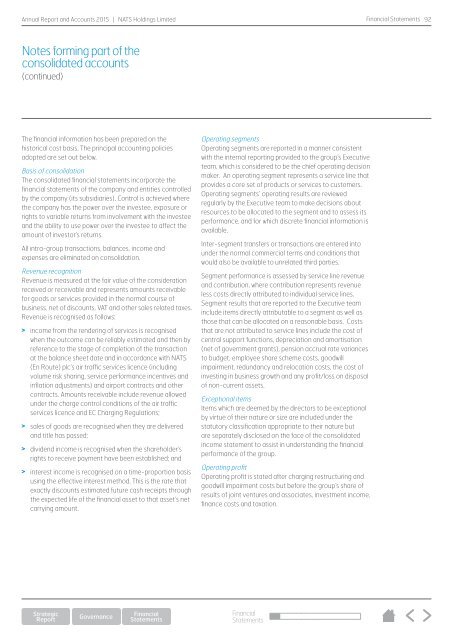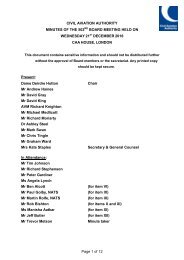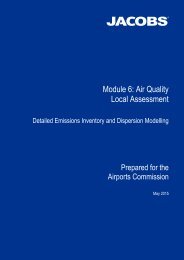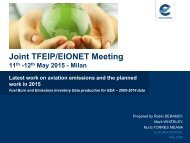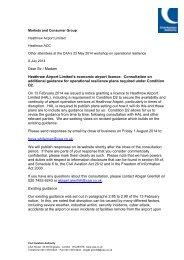NATS-Annual-Report-2015
NATS-Annual-Report-2015
NATS-Annual-Report-2015
Create successful ePaper yourself
Turn your PDF publications into a flip-book with our unique Google optimized e-Paper software.
<strong>Annual</strong> <strong>Report</strong> and Accounts <strong>2015</strong> | <strong>NATS</strong> Holdings Limited<br />
Financial Statements 92<br />
Notes forming part of the<br />
consolidated accounts<br />
(continued)<br />
The financial information has been prepared on the<br />
historical cost basis. The principal accounting policies<br />
adopted are set out below.<br />
Basis of consolidation<br />
The consolidated financial statements incorporate the<br />
financial statements of the company and entities controlled<br />
by the company (its subsidiaries). Control is achieved where<br />
the company has the power over the investee, exposure or<br />
rights to variable returns from involvement with the investee<br />
and the ability to use power over the investee to affect the<br />
amount of investor’s returns.<br />
All intra-group transactions, balances, income and<br />
expenses are eliminated on consolidation.<br />
Revenue recognition<br />
Revenue is measured at the fair value of the consideration<br />
received or receivable and represents amounts receivable<br />
for goods or services provided in the normal course of<br />
business, net of discounts, VAT and other sales related taxes.<br />
Revenue is recognised as follows:<br />
> income from the rendering of services is recognised<br />
when the outcome can be reliably estimated and then by<br />
reference to the stage of completion of the transaction<br />
at the balance sheet date and in accordance with <strong>NATS</strong><br />
(En Route) plc’s air traffic services licence (including<br />
volume risk sharing, service performance incentives and<br />
inflation adjustments) and airport contracts and other<br />
contracts. Amounts receivable include revenue allowed<br />
under the charge control conditions of the air traffic<br />
services licence and EC Charging Regulations;<br />
> sales of goods are recognised when they are delivered<br />
and title has passed;<br />
> dividend income is recognised when the shareholder’s<br />
rights to receive payment have been established; and<br />
> interest income is recognised on a time-proportion basis<br />
using the effective interest method. This is the rate that<br />
exactly discounts estimated future cash receipts through<br />
the expected life of the financial asset to that asset’s net<br />
carrying amount.<br />
Operating segments<br />
Operating segments are reported in a manner consistent<br />
with the internal reporting provided to the group’s Executive<br />
team, which is considered to be the chief operating decision<br />
maker. An operating segment represents a service line that<br />
provides a core set of products or services to customers.<br />
Operating segments’ operating results are reviewed<br />
regularly by the Executive team to make decisions about<br />
resources to be allocated to the segment and to assess its<br />
performance, and for which discrete financial information is<br />
available.<br />
Inter-segment transfers or transactions are entered into<br />
under the normal commercial terms and conditions that<br />
would also be available to unrelated third parties.<br />
Segment performance is assessed by service line revenue<br />
and contribution, where contribution represents revenue<br />
less costs directly attributed to individual service lines.<br />
Segment results that are reported to the Executive team<br />
include items directly attributable to a segment as well as<br />
those that can be allocated on a reasonable basis. Costs<br />
that are not attributed to service lines include the cost of<br />
central support functions, depreciation and amortisation<br />
(net of government grants), pension accrual rate variances<br />
to budget, employee share scheme costs, goodwill<br />
impairment, redundancy and relocation costs, the cost of<br />
investing in business growth and any profit/loss on disposal<br />
of non-current assets.<br />
Exceptional items<br />
Items which are deemed by the directors to be exceptional<br />
by virtue of their nature or size are included under the<br />
statutory classification appropriate to their nature but<br />
are separately disclosed on the face of the consolidated<br />
income statement to assist in understanding the financial<br />
performance of the group.<br />
Operating profit<br />
Operating profit is stated after charging restructuring and<br />
goodwill impairment costs but before the group’s share of<br />
results of joint ventures and associates, investment income,<br />
finance costs and taxation.<br />
Financial<br />
Statements


